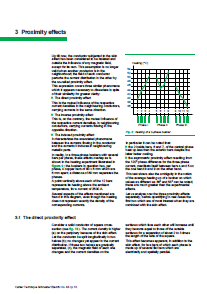Losses and the heating
Electricians have known for a little over a century, since 1873, that alternating currents have a preference for moving at the periphery of solid conductors. In itself, this characteristic would not be a nuisance if it did not lead to extra losses of energy. In a solid conductor, the losses and the heating take place as if the effective A.C. resistance were higher than the actual D.C. resistance.
The increase in resistance which can be of the order of 10 to 20% for conductors designed for 2000 A, grows much faster than the increase in cross section for carrying higher currents.
- Waste of electric energy through supplementary losses; more recently industrialists have recognised that these latter represent a luxury which is not limited only to financial considerations.
- Waste of raw materials, copper or aluminium, because of the larger amounts of metals used, and badly used, as electrical conductor.
Energy losses in the relatively short conductors of distribution equipment are generally only taken into account as far as their physical effects are concerned: heating and evacuation of calories.
However the economic aspects of the energetic efficiency of a conductor are far from negligible at low voltages; it is easy to show that an assembly of conductors having a cross section of 1000 mm2, carrying 2000 A, loses, in a year of continuous use, an amount of energy whose cost is about the same as that of the copper they contain.
An extra loss of 10% due to the skin effect thus represents the price of the copper for the whole lifetime of the installation (20 years with a working factor of 0.5). Kelvin’s law states in fact that the economic cross section of the copper (or aluminium) which has to be used for conductors is that for which the cost of the annual Joule losses is equal to the annual amortisation charges for the copper, plus the other constructional elements proportional to the weight of the copper.
It is of course the role of Merlin Gerin, a manufacturer of switchgear and distribution equipment, to have complete command of the technical problems involved in the design of that equipment. However the job of a manufacturer is not limited merely to supplying products; he owes it to his clients to make available his technical expertise to enable them to install and use the equipment in the best possible way.
The aim of this article will thus be to give the principle and to evaluate the consequences of the skin and proximity effects, and to summarize practical data which can be useful to the responsible for installing busbars carrying high current. These effects start becoming significant for conductors of 1600 to 2000 A, but become very important above 4000 to 5000 A.
AUTHOR: Schneider Electric expert | André DUCLUZAUX
| Title: | Extra losses caused in high current conductors by skin and proximity effects |
| Format: | |
| Size: | 0.4MB |
| Pages: | 22 |
| Download: | Right here | Video Courses | Membership | Download Updates |


